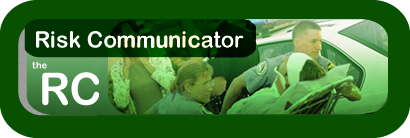The Risk Communicator Newsletter

Providing information and resources to help emergency risk communicators prepare and effectively respond in the event of a crisis.
Collaboration and Communication During Emergency Response
Communication is essential to safety, and safety is usually the top priority during emergency situations and natural disasters. Research shows that in order to ensure optimum effectiveness and efficiency during disasters, public health agencies and emergency response agencies must work together both before and during crises.1
According to the National Association of County and City Health Officials (NACCHO) common elements of successful collaboration are:
- Communicating and providing local input during the planning process.
- Involving state associations of local health officers; setting protocols.
- Adopting a regional approach to planning.
- Adopting a system-wide approach to planning.2
To achieve effective partnerships to enhance interagency communication, public health officials need to build relationships ahead of time, through both individual outreach and agency-focused events. Local, regional, national, or international workshops or conferences are some of the best ways to interact with colleagues from different agencies and develop personal relationships with them. Such conferences provide valuable opportunities to “meet everybody face to face and discuss who should be contacted first regarding certain [emergency] situations.”2
Another path to creating partnerships is to host an emergency preparedness workshop with public information officers, policy makers, and first responders from the surrounding region. Topics of discussion may include emergencies that are indigenous to the area (e.g., hurricanes or wildfires) as well as other crises such as West Nile virus or terrorist attacks. Involving a wide range of participants will encourage input about theoretical, financial, and practical perspectives on the topics discussed.
As a result of communication failures during recent emergency events (including Hurricane Katrina’s aftermath), there is increased attention on the need for redundant systems to keep the public informed and educated about public health activities, especially during an emergency.3 Community partnerships—particularly between emergency management, first responders, law enforcement, and the healthcare delivery system—provide a strong platform for messaging that is consistent across agencies and channels. By reaching out at both the individual and agency levels, risk communicators can foster important relationships to help resolve emergencies as efficiently and quickly as possible.
1 Wetta-Hall R, Berg-Copas G, Herrmann M, Kang S, Orr S, Molgaard C. Regionalization: Collateral benefits of emergency preparedness activities. J Public Health Manag Pract 2007;13(5), 469–475.
2 Bashir Z, Lafronza V, Fraser MR, Brown CK, Cope JR. Local and state collaboration for effective preparedness planning. J Public Health Manag Pract. 2003;9(5):344–351.
3 Morrow C. Public health emergency preparedness and the evolution of public health in the 21st century. J Public Health Manag Pract 2007;13(5):439–440.- Page last updated December 20, 2010
- Page last reviewed December 20, 2010
- Content source: Office of Public Health Preparedness & Response (OPHPR) > Division of Emergency Operations (DEO) > Emergency Risk Communication Branch (ERCB)xxxx
Get email updates
To receive email updates about this page, enter your email address:
Contact Us:
- Centers for Disease Control and Prevention
1600 Clifton Rd
Atlanta, GA 30333 - 800-CDC-INFO
(800-232-4636)
TTY: (888) 232-6348 - Contact CDC-INFO



